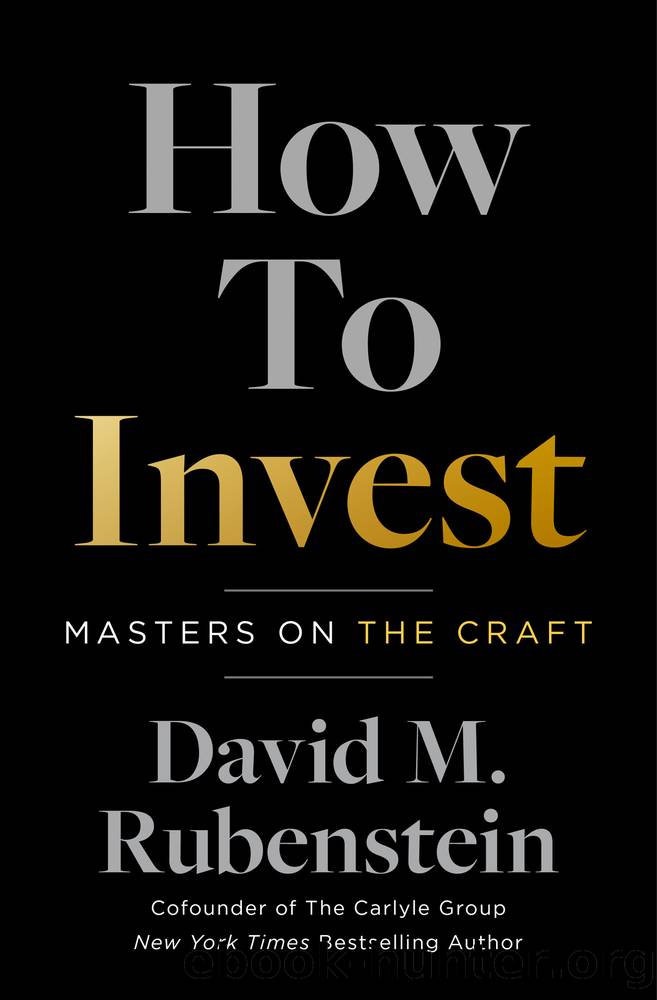How to Invest by David M. Rubenstein

Author:David M. Rubenstein
Language: eng
Format: epub
Publisher: Simon & Schuster
Published: 2022-09-13T00:00:00+00:00
I. A stop/loss order requires a broker to buy or sell a clientâs position in a stock as soon as the stock achieves a certain priceâregardless of the reason. These orders are generally used to prevent further losses if a stock is going down or to lock in a profit if a stock is going up.
JIM SIMONS
Founder, Renaissance Technologies; mathematician and philanthropist
âThe way Iâve really succeeded is by surrounding myself with great people.â
Great investors have traditionally relied on their intuition in making major investment decisions, though that intuition has typically been applied after a review of some type of information or data. The theory had always been that no type of machine-made decision could possibly be better than a human decision.
That is probably still true in most areas of investing. But in some areasâpublicly traded securities, commodities, and currenciesâthe advent of sophisticated computers, using the best possible data, has spawned an approach known as quantitative investing. In this type of investing, complex computer-spawned algorithms are developed to take advantage of market inefficiencies, even if the inefficiencies exist for very brief periods. The result can be rapid computer-driven market sales or purchases, with potentially very high returns.
The undisputed master of this type of investing for the past three-plus decades has been Jim Simons, whose Renaissance Technologies hedge fund has achieved investment returns thought to be all but impossible. For his flagship Medallion fund (now available only to employees), average annual net returns have apparently exceeded 40 percent for more than 30 years.
As is often the case in the investment world, Jimâs spectacular returns attracted many others to use their math and quantitative expertise to build similar investment firms. And while all of these firms, including Jimâs, have complex algorithms that were developed by humans, the notion took hold that computersâproperly programmed by humansâcould make investment decisions and act on them better and more quickly than a human. This was revolutionary in the investment world, though the idea that machines can outperform humans in certain areas of investing is now largely the accepted wisdom.
Jim came to the investment world relatively late in a career that had earlier been focused on his real passionâmathematics. In that area, he was a world-class mathematician, leading the math department at the State University of New York at Stony Brook (from the age of 30) and developing award-winning math theorems. But he left his math career behind himâa rare occurrence in the math worldâto develop a way in which his expertise could be applied to the trading world. The result changed the investment world forever.
Jimâs firm helped launch an industry where math and science skills are the coin of the realm in developing trading programs. Many others have followed him into the varied world of quant investing, but no one has exceeded his multiyear track record, and it seems no one is likely to do so anytime soon.
Jimâs success has enhanced his philanthropic efforts, many of which are focusedânot surprisinglyâon advancing research in math and science.
I have known Jim for many years, initially introduced by friends who had invested with him.
Download
This site does not store any files on its server. We only index and link to content provided by other sites. Please contact the content providers to delete copyright contents if any and email us, we'll remove relevant links or contents immediately.
Harry Potter and the Goblet Of Fire by J.K. Rowling(3046)
Never by Ken Follett(2884)
Shadow of Night by Deborah Harkness(2718)
Ogilvy on Advertising by David Ogilvy(2682)
Zero to IPO: Over $1 Trillion of Actionable Advice from the World's Most Successful Entrepreneurs by Frederic Kerrest(2397)
The Man Who Died Twice by Richard Osman(2300)
Machine Learning at Scale with H2O by Gregory Keys | David Whiting(2293)
Book of Life by Deborah Harkness(2263)
How Proust Can Change Your Life by Alain De Botton(2261)
My Brilliant Friend by Elena Ferrante(2224)
0041152001443424520 .pdf by Unknown(2220)
The Tipping Point by Malcolm Gladwell(2205)
How to Pay Zero Taxes, 2018 by Jeff A. Schnepper(2100)
Will by Will Smith(2043)
Purple Hibiscus by Chimamanda Ngozi Adichie(1982)
Hooked: A Dark, Contemporary Romance (Never After Series) by Emily McIntire(1964)
Borders by unknow(1786)
Rationality by Steven Pinker(1765)
Daughter of Smoke and Bone by Laini Taylor(1744)
